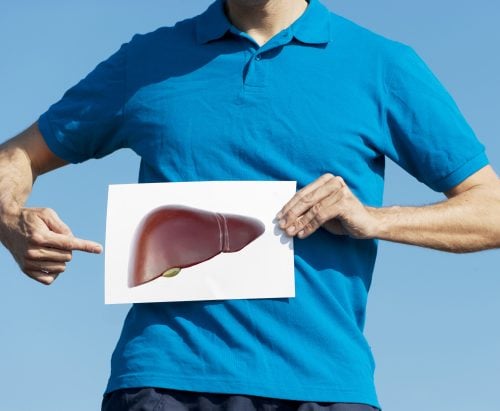
What is fatty liver disease and how can you protect your liver best? Fatty liver disease researchers Kirsten Coppell and Kiri Sharp explain.
While fatty liver sounds a bit like something you might order at a French restaurant, it is actually a term used to describe an excess of fat in your liver cells.
When a build up of fat in liver cells makes up at least five per cent of a person’s liver, they have fatty liver disease.
Non-alcoholic fatty liver disease (NAFLD) has emerged as a common obesity-related liver condition, affecting up to 30 per cent of adults in developed countries. It is now the most common chronic liver disease worldwide.
About the liver
The liver is a large essential organ located in the upper right part of the abdomen. It has many functions including storing fuel for the body as glycogen (a storage form of glucose), making important proteins, and helping to metabolise and remove alcohol and toxins from the body.
What is fatty liver disease?
NAFLD is a term that describes a range of conditions caused by too much fat stored in the liver in people who drink little or no alcohol. Fatty liver disease can also develop in people who drink excessive amounts of alcohol but this is, instead, called alcoholic fatty liver disease (AFLD). There are other causes of a fatty liver, such as some medicines and hereditary disorders, but these are uncommon. All other potential causes of a fatty liver need to be excluded before NAFLD can be confirmed. This article primarily focuses on NAFLD.
In its simplest form, NAFLD is called ‘simple fatty liver disease’. This is where there are higher than normal amounts (over five per cent) of fat stored in the liver cells.
In the more serious forms of the disease, there is also inflammation and scarring in the liver, which can lead to liver failure and, rarely, liver cancer.
Excess fat in the liver cells along with inflammation is called non-alcoholic steatohepatitis, where ‘steato’ means fat and ‘hepatitis’ means inflammation of the liver.
When scar tissue is present in the liver, this is called fibrosis. If this scar tissue replaces a lot of normal liver tissue, this affects the function of the liver, and is called cirrhosis.
Most people with NAFLD have simple fatty liver disease. Only a small number develop the more serious form, and it is not known why. But, all people with the disease have an increased risk of developing cardiovascular disease such as heart attack and stroke.
What are the risk factors?
Excess body weight (overweight and obesity) is a widely recognised risk factor for NAFLD, and the emergence of NAFLD has paralleled the obesity epidemic. But not everyone who is obese develops the disease, and some people who are only slightly overweight or normal weight develop NAFLD, but that number is relatively small. We don’t know why this is yet. NAFLD is also commonly associated with high blood pressure, abnormal blood lipid levels and abnormal blood glucose levels, and is now considered to be part of a group of factors that can raise heart disease, stroke and diabetes risk called metabolic syndrome.
The risk of the disease increases with age, but we are starting to see it diagnosed in children and adolescents. It’s also frequently diagnosed in those with type 2 diabetes.
How is the disease diagnosed?
Most people with NAFLD have no symptoms. Among those who do, the most common symptom is fatigue. Some people experience discomfort in the upper right part of the abdomen, and a few may have itchy skin. As most people with NAFLD have no symptoms or their symptoms are nonspecific, the disease is often diagnosed incidentally.
Diagnosing NAFLD isn’t that straightforward and there’s not a simple test to pick it up. Quite often it’s considered after a blood test to measure liver function comes back abnormal, and other liver conditions are ruled out. But liver function tests are not always abnormal with NAFLD, and the disease may be diagnosed following an abdominal ultrasound scan. Sometimes people with NAFLD may require further tests to see if they have a serious form of the disease.
What about treatment options?
NAFLD is a lifestyle disease and drug treatments are still unclear. Therefore, the only option for the prevention and treatment of this increasingly common liver disorder is lifestyle modification (diet, exercise and not smoking), along with the treatment of any associated conditions, including diabetes, pre-diabetes, high blood pressure and abnormal lipid levels. For most people, the mainstay of treatment is a 7-10 per cent weight loss through dietary changes and exercise, but gastric bypass surgery may be considered in some circumstances.
What to do for liver health
- Aim for a healthy body weight.
- Limit food and drinks high in added sugars.
- Eat a healthy balanced diet that includes fruit, vegetables, whole grains, legumes, lean meat, fish, nuts and small amounts of healthy fats, such as olive oil or canola oil.
- Limit or cut out alcohol to avoid further liver injury.
- Move every day – get your heart pumping and use your muscles (see Making time to exercise for easy ways to fit exercise into your day)
- Stop smoking – talk to your GP or Quitline for help.
Article sources and references
- Chalasani N et al. 2012. The diagnosis and management of non-alcoholic fatty liver disease: Practice Guideline by the American Association for the Study of Liver Diseases, American College of Gastroenterology, and the American Gastroenterological Association. Hepatology 55:2005-23https://www.ncbi.nlm.nih.gov/pubmed/22488764
- Coppell KJ et al. 2015. Obesity and the extent of liver damage among adult New Zealanders: findings from a national survey. Obesity, Science and Practice 1: 67-77https://www.ncbi.nlm.nih.gov/pmc/articles/PMC5063157/
- European Association for the Study of the Liver (EASL), European Association for the Study of Diabetes (EASD) & European Association for the Study of Obesity (EASO). 2016. EASL-EASD-EASO clinical practice guidelines for the management of non-alcoholic fatty liver disease. Diabetologia 59:1121-40https://www.ncbi.nlm.nih.gov/pubmed/27053230
- Lazo M et al. 2013. Prevalence of nonalcoholic fatty liver disease in the United States: the Third National Health and Nutrition Examination Survey, 1988-1994. American Journal of Epidemiology 178:38-45https://www.ncbi.nlm.nih.gov/pubmed/23703888
www.healthyfood.com










